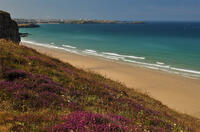Whipsiderry beach

The name of Whipsiderry Beach arises from some old mining terms: whips (marker flags) and derrick (an elevated structure for haulage situated over a shaft). It is recorded that the Derrick - resembling gallows - was named after a famous hangman by that name.
A cave on the side of Porth Island was enlarged in the 1870s as part of the Porth Island Silver and Lead Mine workings. In the 1920s-30s, a harmonium was wheeled in here at low tide for candlelight concerts and consequently became known as the Concert Cavern or Banqueting Hall. It eventually became unsafe and was mostly demolished with explosives.
Another cave near this, known as Cathedral Cavern, has a pillar and a series of intersecting tunnels. This was once quarried, it is reported, for white marble. Marble is not common in Cornwall, but a bed of it was found deep in a mine fairly nearby in Perranporth so this might be related.
There are also two smaller caves on Whipsiderry Beach named according to their contents: Fern Cavern and Boulder Cavern.
- Tide times
- Beach info
- Map
- Dogs: allowed all year
Walks visiting Whipsiderry beach
-
4 miles/6.4 km - Easy-moderate
Watergate Bay to Newquay (via bus)

Watergate Bay to Newquay (via bus)
4 miles/6.4 km - Easy-moderate
A one-way coastal walk, made circular via an initial bus journey, from Watergate Bay along the coast path to Newquay, passing the sea caves at Whipsiderry beach, the Iron Age hillfort on Trevelgue head and the beaches of Porth, Lusty Glaze and Tolcarne.
Download the iWalk Cornwall app and use the QR scanner within the app to find out more about any of the walks above.


